The most interesting behavioral fact about squirrel monkeys is they are one of the most intelligent and cleverest primate species. That’s why they like to hunt their food more intellectually rather than aggressively.
Also, they always try to avoid trouble as much as they can using their intelligence instead of getting physical. Moreover, they can do thermoregulation, osmoregulation, and territorial marking. Also, they are omnivores and polyandrous or polygamous.
In this article, we will discuss different behavioral facts of this monkey species. You will also understand what can cause changes in their behavior and how to conserve their natural behaviors. Now, let’s go through the article.
A Quick Overview of Behavioral Facts Of Squirrel Monkey
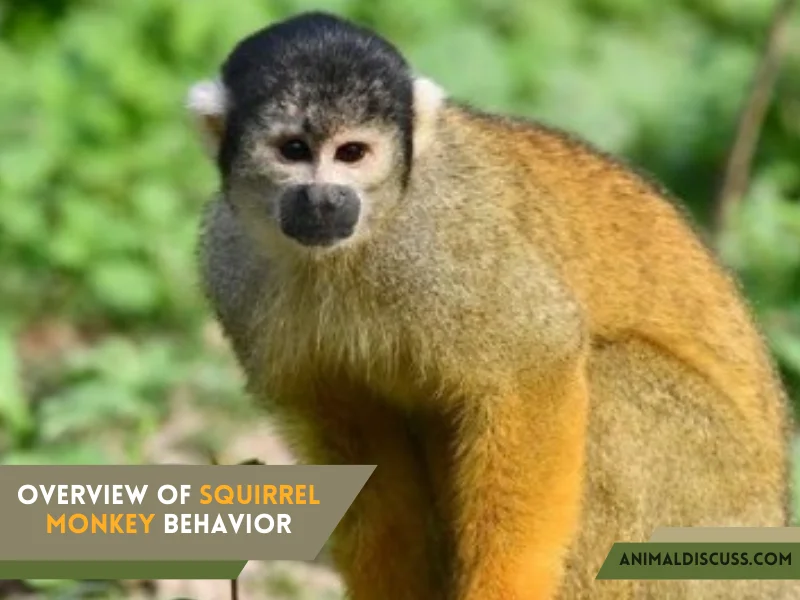
Squirrel monkey shows numerous behavior traits according to their emotions, feelings, and needs. They are mentioned in the following table for a quick overview.
| Habits And Behaviors | Descriptions |
|---|---|
| Growing Habits | 1. After weaning, they start searching for their food. 2. They also develop osmoregulatory and thermoregulatory habits to cope with extreme environments. |
| Feeding Habits | 1. Eat fruits, nuts, leaves, insects, etc. 2. Swap between their frugivorous and insectivorous food habits depending on the food adequacy. |
| Breeding Habits And Migrational Patterns | 1. Breeding season in September-November 2. Form migratory alliances to support each other during immigration, even on normal days. |
| Aggression And Territorial Behavior | 1. Squirrel monkeys hardly get into fights except during food scarcity or mating seasons. 2. They mark their territory with their urine or fur secretions. |
| Ecological Adaptations | 1. This animal maintains ecological balance by eating insects and being the prey of predator groups. |
| Social Behavior | 1. They are highly social and remain in groups. 2. Communicate with each other through 25-30 types of vocalizations |
Why Do Squirrel Monkeys Behave Significantly?
This animal will show a difference in their behavior with changing situations. Thus, any abnormal and drastic changes in their behavior will show that they are in a poor welfare state. Here are some reasons of their behaving significantly:
DNA: Due to their DNA, they are too small to fight their predators. They need to live in groups to deal with their predators.
Nature: In their natural habitats, they do thermoregulation and osmoregulation to cope with the extremely hot weather.
Survival: They aren’t picky eaters because they need to swap their food diets to survive during food scarcity.
You need to understand their behavior well to distinguish between their reasoning. This is an essential requirement in captivity while caring for or training a squirrel monkey.
Significance of Understanding the Diversified Behavior of Squirrel Monkeys
Here are several importance of understanding their diversified behavior:
Research purposes: By studying their diversified behavior, researchers gain insights into their primate behavior evolution. It will also help to get an idea about this primate’s origin of arrival and ancestors.
Understanding Their Social Systems: You may understand their communication, cooperation with each other, mating, and parental strategies by observing their diversified behavior. This will help you to understand their social complexity and systems.
Understanding Their Intellectual: These monkeys are intelligent species and good at solving problems without creating trouble. By studying their behavior, researchers can explore the cognitive processes underlying these abilities.
Welfare Purposes: Understanding their natural behavior helps create environments stimulating biological and psychological well-being. It will let them display species-specific behaviors and lessen the anxiety associated with captivity.
If you are interested in learning more about the squirrel monkeys, you may read my article.
Growing Habits Of Squirrel Monkey: Structural And Physical Adaptations
During the growing period of this primate species, you may find changes in their behavior depending on their ages. Here are some:
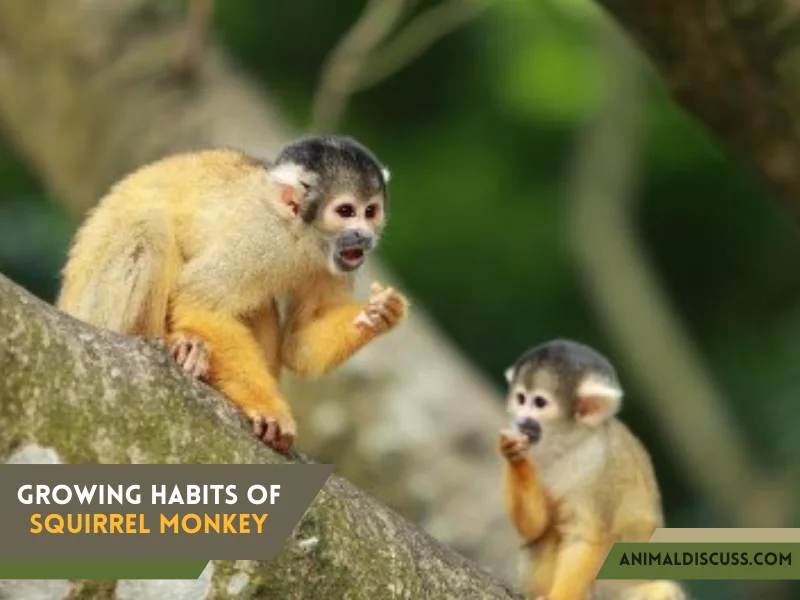
Growing Cycle
At young ages, like below four months, or in some species below 18 months, they depend on their mother for food. Until one month of their age, they will feed on their mother’s milk.
After this one month, they will start taking solid foods that their mother will provide them. Then, after this period, they have to live independently and need to search for their food.
After 2-5 weeks of birth, they start developing their hearing ability, and their mothers also start vocalizing. But, the young will begin vocalizing within 6-12 months of their age.
Within 2-2.5 years, the female will become sexually mature, whereas it takes 3.5-4 years for the male to become sexually mature.
Body Size, Weight, and Shape
This animal species has a tiny, agile, and slender body shape. Their body size generally ranges around 9.8-13.8 inches, depending on their species. Besides, they have a long tail which can be 14-17 inches long.
Generally, male monkeys weigh more than female monkeys. Whereas the male ones have 750-1100 grams weight, the female members will weigh around 500-750 grams.
Skin and Fur
Though their fur is short, it’s dense. The color of these dense furs is blackish near their shoulders. Yet, this color will turn yellowish-orange or brown around their back and extremities.
The skin color of their face is primarily white, and has black patches around their eyes.
Physical and Structural Adaptation
Here are some of their physical and structural adaptations:
Brain: They have bigger brains in comparison with their body size. That is why they are the most intelligent among the primates and can solve problems that they face in their daily life.
Hearing: They can even hear white noises. As a result, they can sense the presence of their predators easily. Besides, this ability will also help them in their preying.
Tails: The squirrel monkey has a larger tail than their body proportions. Unlike other monkey species, they can’t hold or grab anything with their tail, and this tail helps them to hold their balances.
Teeth: This monkey has large and sharp cusps. With their large cusps, they generally prey on insects.
Movement: If you monitor them carefully, you will notice that this primate species has smaller thighs than their lower leg. Due to this adaptation, they can jump higher and larger distances.
Fingers: Their hands’ fingers are well-developed and dexterous. Hence, they can grab onto the trees, pluck fruits, and search for hidden fruits and insects with their hands.
Special (Evolutionary) Adaptations
Normally, their evolutionary and special adaptations occur due to coping with the humidity and temperature changes. Let’s know more:
Osmoregulation: Sometimes, the relative humidity of their habitat can go above 85%, where they tolerate a maximum of 75%. In this case, they will change their osmoregulation rate by intake less amount of water.
Because, in this high relative humidity, water loss through evaporation will also reduce. Thus, their urine will be more concentrated for balancing the adequate water and ion level in the body.
Thermoregulation: They only can sweat through their palms, which isn’t enough to cope with the excessive heat of their native habitats. That’s why you may see them using the urine-washing method as thermoregulation.
They will urinate and rub their urine all over their body. As a result, the urine will evaporate from their body and will maximize the method of evaporation cooling as sweats do.
Growth Habit Differences Among Species
There are some differences in their growth habit depending on their species:
- The Black-Capped squirrel monkeys are slightly larger than Guianan squirrel monkeys. On the other hand, the Central American squirrel monkey species is somewhat smaller than other species.
- The Guianan squirrel monkey’s tail length is around 36-47 cm. Yet, the Central American squirrel monkey has a slightly shorter tail of 36-38 cm.
- Black-Capped Squirrel Monkeys have a black crown on their head. Then, the rest of their body is predominantly grayish-brown. Yet, the Guianan Squirrel monkey’s back is olive green, and the head is yellowish orange.
Feeding Habits Of Squirrel Monkey
Generally, these primate species are omnivores which means they can feed on both plants and animal food sources. They have both general and special feeding habits, let’s see in detail:
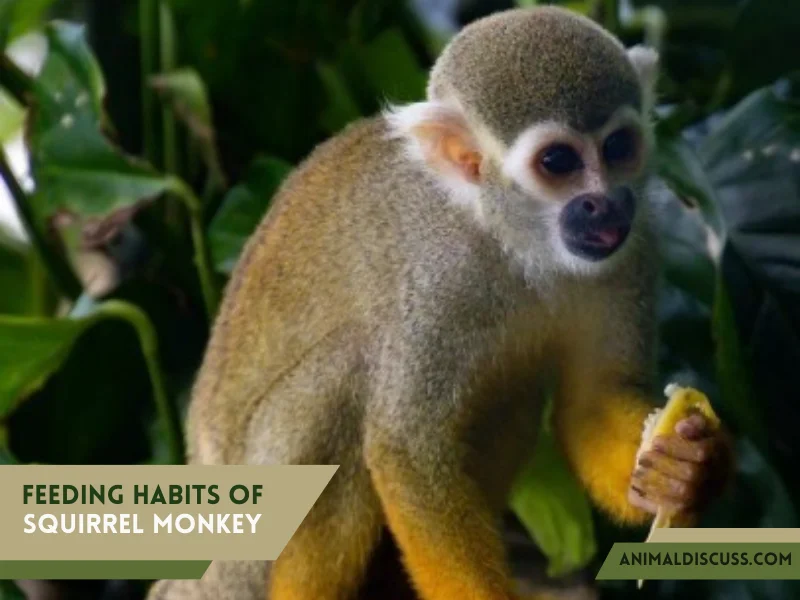
Feeding Habit
They keep foraging and searching for food for almost half of their day. Then, they will use 11% of their day for eating nectar or fruits.
You can see them holding food in their hands while peeling or taking a bite from the food.
How They Hunt
Typically, you will find them uninterested in preying on moving insects. Rather, they are more interested in insects that are stable and easy to prey on.
You may find them searching insects by unfolding any leave curl, turning the dead lives, or even on live leaves.
The squirrel monkeys will use spring traps to prey on lizards or birds. After finding their nests, this monkey will jump on them from above. Then, they will prey on them using their long fingers, sharp claws, and teeth.
How They Feed Their Young
Usually, the young of this monkey will feed on milk until they start eating normal foods. When there is the availability of food sources, they will get weaned and will forage with adults for food.
In general, the squirrel monkeys can join troops to search for food together. If food sources are abundant, the in-group competition will be less. But, if the food is scarce, there will be direct competition between groups.
Special Adaptations for Feeding
This monkey species can adapt its food habits to a few factors like climate, scarcity of food, etc. Here are those special adaptations of their food habits:
- They can switch between their frugivore and insectivore habits according to the climate and food availability.
- When the fruits are adequate, they are usually frugivorous or prey on animals that primarily depend on fruits for food. But, when the fruit sources become scarce in the dry seasons, this animal will live on eating insects.
- Squirrel monkey species can intake water from tree holes and puddles instead of going to water sources. The reason is, if they descend from the tree or go to an open water source, they will be exposed to their predators.
- Their highly color-sensitive eyes help them to find their fruits in the dense forest.
- This primate species has excellent eye power, which they use to detect the motion of small insects and hunt their prey.
Breeding (Mating) Habits And Migration Patterns Of Squirrel Monkeys
Normally, you will find these small primates in South or Central America’s tropical forests. Within their range, they will migrate in groups in search of food. Here are some examples of their mating and migratory behavior:
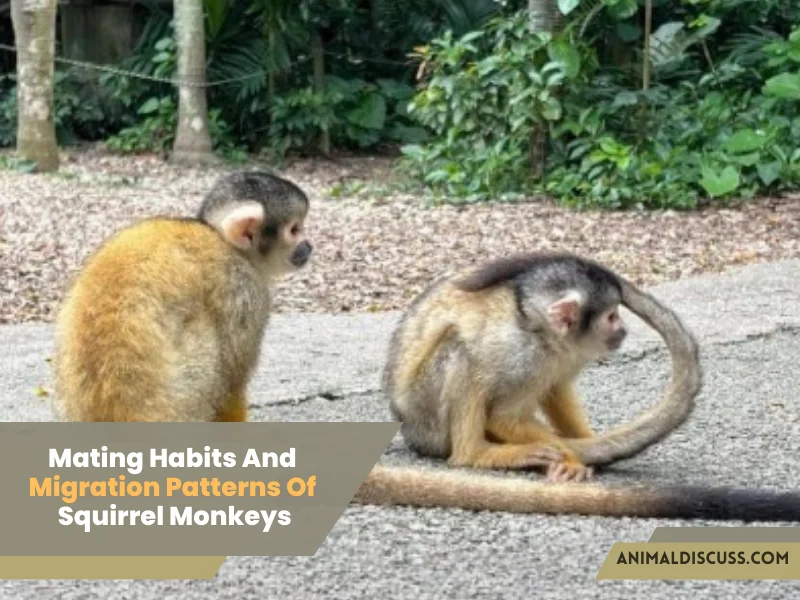
Mating Season
Their breeding behavior generally will depend on the season, which is between September-November. Typically, females get sexual maturity at 2.5 years, whereas males get it at four years. After obtaining sexual maturity, they will mate during their breeding seasons.
Courtship Habit
As courtship behavior, the male can use their vocalizations to draw the attention of the females. Also, grooming each other furs will indicate their mutual interest in mating. Moreover, the genital display is also a part of their courtship behavior
Sometimes, they also use urine washing or fur secretion to signify their sexual availability and to attract the opposite gender.
Gestation Period
Their mating season is between September-November, and the gestational period will be of almost 160-170 days.
The birth season will be during rainfall or at the beginning of the wet seasons. In this way, there will be adequate food and water sources when they give birth.
Number Of Youngs
A squirrel monkey can only give birth to one young at one time. Usually, the mother monkey takes care of her baby without help from the father.
Sometimes, you can notice that the female will chase away the males after giving birth.
Even though the male members don’t take care of their young, they may behave aggressively to protect those young.
Migrating Behavior
The male members generally make a migration alliance within which they support each other against other alliance’s males during the courtship behavior.
This male alliance won’t function in overcoming the female monkey’s dominance.
During the breeding seasons, you might see this alliance getting wider or smaller. Normally, when there is in-group competition over the female mates, the alliance will get apart.
But, if a new mating scope creates between two different groups, they will create or widen their alliance with the new group.
Special Sexual Adaptations
Near January, a sexually mature male squirrel monkey will go through some hormonal changes. There will be an increase in the level of their androsterone, testosterone, and dehydroepiandrosterone hormones.
As a result, you will notice that their size is getting relatively larger than the female members.
This size change refers to their reproductive ability. Usually, the larger their size, the higher the chance that the females will choose them as mates. Thus, their chances of copulation with multiple female mates will also increase.
Normally, female monkeys are polyandrous. Because as you can see, their mating season is too small, so being monandrous can reduce the chance of their getting pregnant. Hence, mating with multiple mates will increase their chances of getting pregnant.
Ecological Adaptations Of Squirrel Monkeys
In a food chain, these animal species are both prey and predators of different groups of animals. Normally, this species helps to keep balance in the food chain and overall ecosystem.
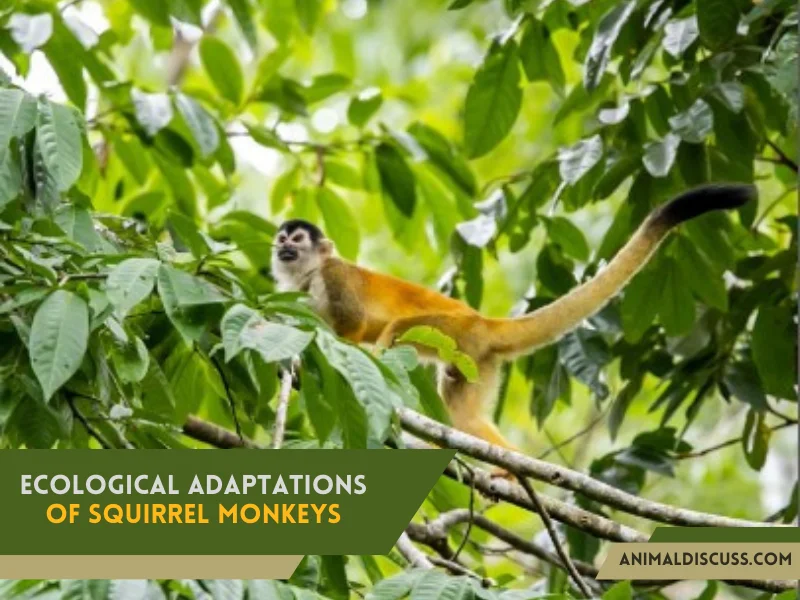
Here are their several ecological roles and adaptations:
Restoring Forest Adaptation: This primate species can survive both in primary and secondary forests. Though the primary forests have adequate plant growth, the secondary forests are in restoring state after any devastation.
But, as a non-picky eater, this animal can survive even in the secondary forest by eating what they get.
Pest Control: Generally, they play a vital role in pest control within the forest. This will enhance the overall environmental quality of the forest.
Better Plant-Growth Environment: Some insects are fed on plant leaves which may cause the death of many small plants.
Thus, the squirrel monkeys will help to provide the plants with a better growth environment by controlling the insect population.
Pollinators And Fertilizers: This primate species also act as pollinators in the forest. As you know, they primarily eat fruits, they will release the seeds through their feces. Also, their feces are good fertilizers for plants.
Hence, they will not just spread the seeds throughout their foraging ranges but will also provide good fertilizer for plants.
Food Source: Many birds of prey, snakes, and large wild cats are predator groups of this monkey. These predator groups may need to search for another food source or even may not survive without the squirrel monkeys.
Aggression And Territorial Habits Of Squirrel Monkey
This monkey species are generally not aggressive without any extreme reasons. Yet, they are territorial and love to mark their territory. Here, we will provide you with some ideas about their aggression and territorial behaviors:
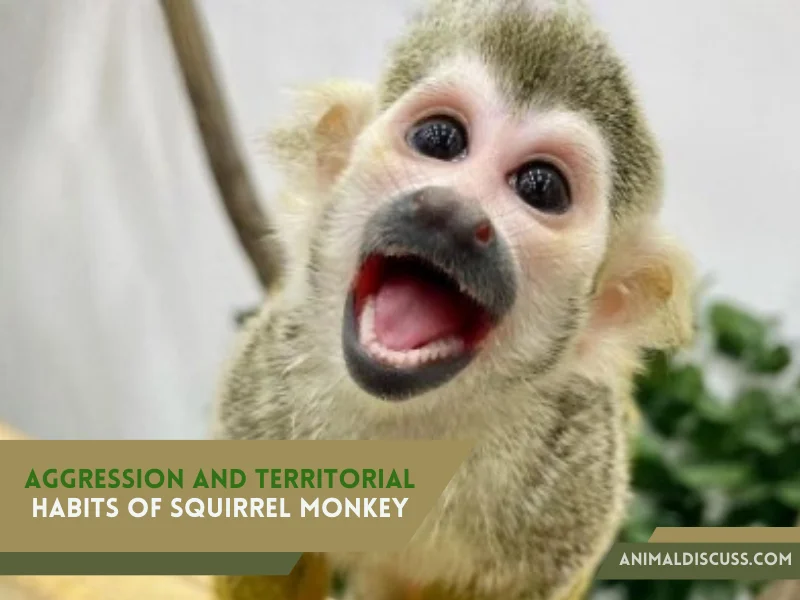
As Predators
Generally, they aren’t aggressive predators as they primarily depend on plant food sources for food. Instead of being aggressive, they prey intelligently. Besides, you will always find them trying to avoid any type of danger or trouble instead of fighting.
As Prey
Their claws and fingers aren’t sharp enough to attack their predators and they can’t fight against their predators when they are alone. That’s why you will mostly find them foraging in groups and warning each other when they notice any predators.
When in a group, this monkey species will chase off some predators of small or mid-size.
Aggressive During Mating Season
Sometimes, male monkeys can become aggressive toward other male members during the mating season. The member with better dominance will mate with the most female monkeys.
Territorial Marking
They like to mark their territory by urine washing. Sometimes, secretion from their fur also works as scent marking. This smell of their secretion not only will mark their territory but will also keep their predators away. The reason is the predator groups can’t tolerate this smell.
Social Behavior Of Squirrel Monkeys
Squirrel monkeys are extremely social animals as they live in a troop of almost 300-500 individuals. These large troops consist of many sub-troops of 20-55 individuals.
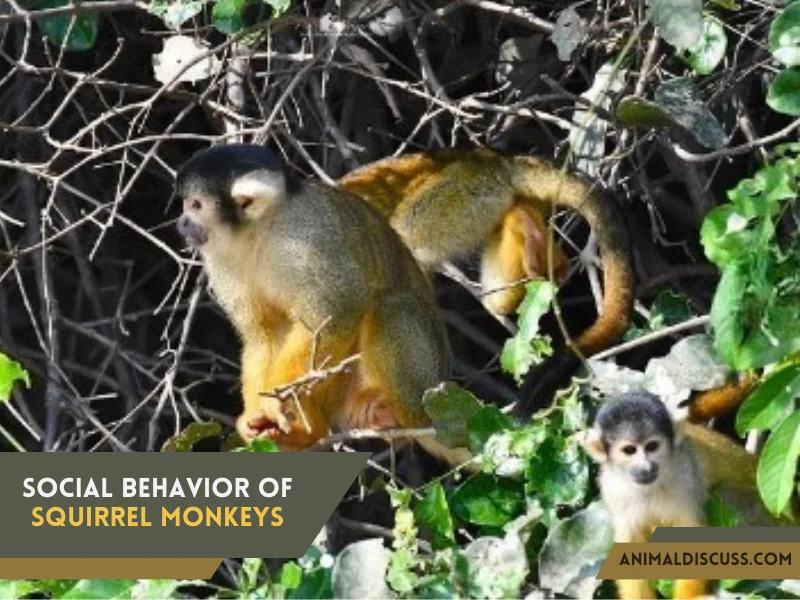
General Habits
Here are some general social habits of this primate species:
- Cooperative foraging is the prime basis of their troop. They forage together to find food easily and reduce the risk of predator attacks.
- Their social hierarchy consists of females, pregnant females, offspring, and males, with the females and offspring at the center.
- Sometimes, you can see the female and young remain in one group, and the males build another foraging group.
- The female squirrel monkeys carry and take care of their children for several months from their birth. After that period, the male young will join the foraging groups, and the female young may stay with their mothers.
- In their troops, adult female members also show affection to the young people within the group. They will play the role of aunt here.
Special Adaptations
Alongside the general social habits, they also have some special habits that result from their adaptations. Here are those:
The female monkeys dominate the young or male members with their pseudo-penises.
They use almost 25-30 types of calls and vocalization for communicating with their troop members. In general, you will hear them making high-pitched sounds to warn against predators. This sound will growl like when they show aggression.
Sometimes, you will also notice that this monkey species rub its urine on its feet and hands. After that, they will jump toward their destination. This will leave a scent and mark of their steps for their following troop members.
Habitual Difference For Different Species
The social behavior of this small primate will vary from one species to another. This difference will be more prominent among three of their species:
- Central American squirrel monkey (Saimiri oerstedii)
- Guianan squirrel monkey (Saimiri sciureus)
- Black-capped squirrel monkey (Saimiri boliviensis)
Let’s see some examples of their habitual differences:
The Saimiri oerstedii species have a higher rate of female intergroup transfer. But, this rate is lower, and the male transfer rate will be higher in Saimiri boliviensis and Saimiri sciureus species.
The Saimiri sciureus species shows a higher in-group competitive behavior in feeding. But you won’t see this behavior in Saimiri boliviensis and Saimiri oerstedii.
The young of the Saimiri oerstedii will live with their mother for at least four months from their birth. On the other hand, the young of the species Saimiri boliviensis will live with their mothers till eighteen months old.
Facts That Influence On Different Behavioral Traits
The squirrel monkeys show a variety of behavior that will depend on many factors, such as:
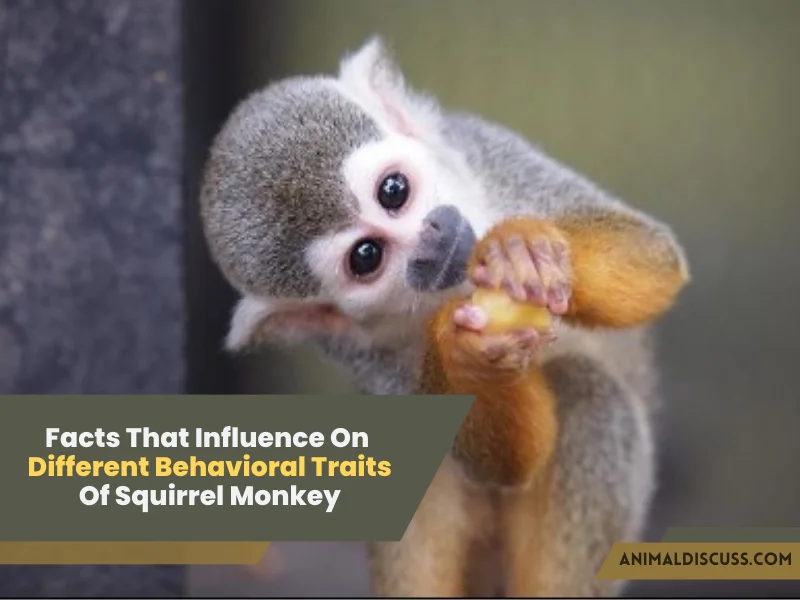
Predator Pressure: If the pressure of predators increases, they will form larger groups than before. This will help them to gang together in chasing away the predators.
Food availability: If there is plenty of food, there is less likely to have any in-group competition during foraging. But, upon the food, they will compete with each other to get the food.
Relation with other groups: Though they can live peacefully and parallelly with many other subgroups, this scenery may also change during mating seasons.
Distress: This animal can be stressed due to harsh weather, food scarcity, or during heat. Thus, during these periods, you see them behaving abnormally, like persistent aggression, eating feces, over-grooming, self-harm, etc.
Diseases: Diseases can also cause changes in their behavior, like lack of activity and changes in sleeping, eating, and drinking patterns. Also, a sick squirrel monkey can lose its temper quickly, and show aggression toward its troop members.
Human-Induced Facts That Changes Squirrel Monkey Behavior
This monkey species shows certain behavior without human disturbance. But, you find changes in their behavior due to several human-induced factors like:
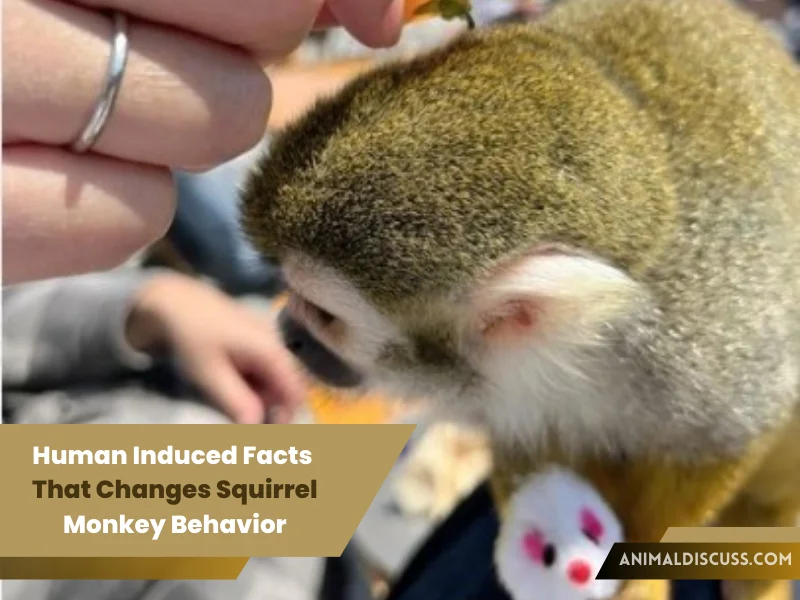
Deforestation: Due to a higher rate of deforestation, squirrel monkey species are getting pushed toward plain areas. Hence, they are creating tantrums for farmers and gardeners.
Noise pollution: This monkey has auditory capability in the 0.125-46 KHz range, whereas for humans, it is 0.02-15KHz. Thus, sound pollution, even those sounds that you can’t hear, can affect their performance.
Change in sleeping pattern: Increased human activity can disturb their sleeping pattern causing them distress.
Training: As they are intelligent primate species, you can train them to act on your command. They can understand what you are saying and can perform tasks accordingly.
Separating them from their group: If you separate them from the group, they will get bored and stressed due to loneliness. This may reduce their vitality in captivity.
Conservation Of Their Behavior
The natural behavior of squirrel monkeys is interrelated with multiple vital facts about the environment and ecology. Hence, conserving their natural behavior is necessary for keeping balance in their biodiversity. Here are some ways this species can be conserved.

International Steps: IUCN listed some species of squirrel monkeys as endangered and some as vulnerable. With this, they also provided expert guidelines for their protection.
Also, the World Wildlife Fund(WWF) focused on providing them with safe habitats and conserving their behavior.
Governmental Steps: The government needs to take strict steps against deforestation to conserve their natural habits so that they don’t have to raid fields and crops.
Avoid Trespassing: You shouldn’t trespass near their habitats, either in the forest or captivity, during their sleeping times.
Awareness Campaign: The awareness campaign is necessary so that people can get an idea about this monkey’s behavior. Thus, they won’t disturb this monkey and won’t get an aggressive reaction from them.
Roles Of Wildlife Associations: Wildlife authorities and welfare organizations should take appropriate steps to discourage excessive human activities near these monkeys’ habitats.
Roles Of Individuals: You should never separate any of these primate species from their groups. If you find any lost ones, you need to contact the wildlife association for their rehabilitation.
In captivity, you need to provide them with enough mental and physical stimulation and environmental conditions that are almost similar to their natural habitats.
Conclusion
Usually, this monkey species has a versatile food diet. During the mating season and food scarcity, they can get competitive and aggressive. Interestingly, they form troops where females dominate over males. In their troop, they use several vocalizations to communicate with each other.
These multiple behavioral facts about squirrel monkeys relate to their adaptations, foraging, escaping predators, communicating, and reproduction, which may change due to human disturbance. Without effective conservation efforts to conserve their natural habits, an imbalance in their reproduction and survival strategies will occur.
That’s why to protect wildlife biodiversity, you need to dig more into this animal’s psychology and take steps accordingly. We recommend reading research pieces on squirrel monkeys to learn more about these fascinating creatures! Alongside, to gain explicit ideas about their diets and habitats, visit the articles regarding these.
References:
- https://www.aucklandzoo.co.nz/news/our-squirrel-monkey-family-has-grown
- https://neprimateconservancy.org/humboldts-squirrel-monkey/
- https://worldanimalfoundation.org/advocate/wild-animals/params/post/1297422/
- https://www.folly-farm.co.uk/zoo/meet-the-zoo-animals/common-squirrel-monkey/
- https://neprimateconservancy.org/humboldts-squirrel-monkey/
- https://academic.oup.com/ilarjournal/article/41/1/26/902365
- https://www.sciencedirect.com/science/article/pii/S0149763421002438
- https://www.sciencedirect.com/topics/biochemistry-genetics-and-molecular-biology/squirrel-monkey

